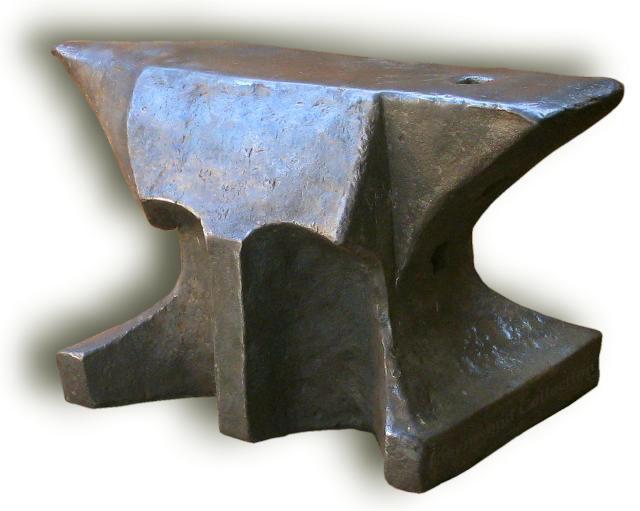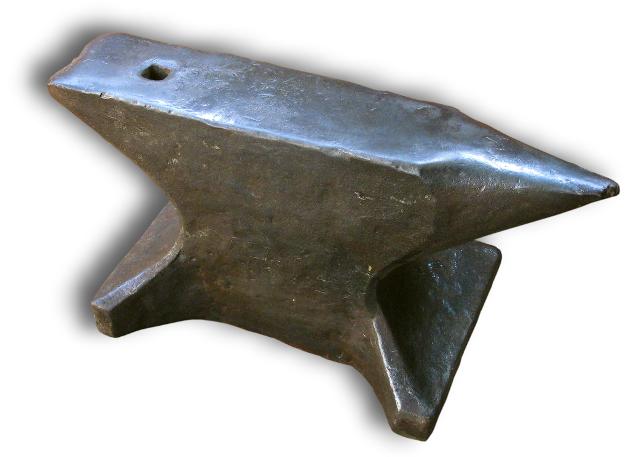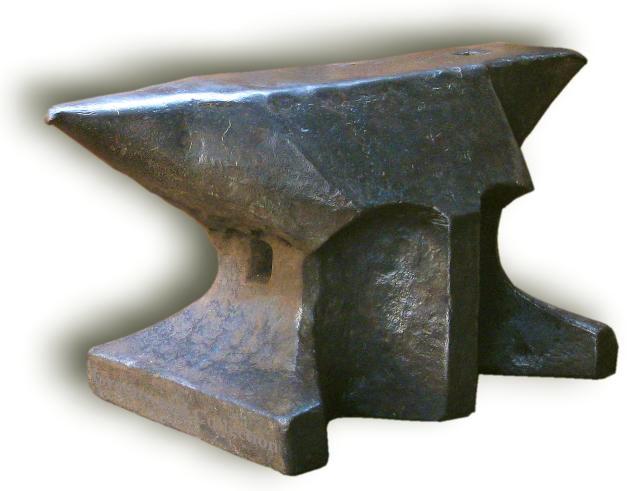From the Josh Greenwood Collection.
The sloped side on these anvils reinforces the far corner where the smith does the most work as well as where strikers would strike heavy sledge hammer blows.
This reinforced middle edge prevents the common breaks and chips you see on later square cornered anvils.
This also results in right and left hand anvils. This one is a left hand anvil.
The center column provides support such that the working edge at the middle of the anvil is supported as if it were the center of the anvil.
The slope results in approximately a 110° to 120° angle. At the heel there is a 90° angle and the back edge is a 60° angle.
The break between the slop and heel provides an inside 90° corner.
The horn blending into the slope results in a much larger radius than found on other anvil designs.


The nearly flat back on this anvil will allow it to be used on its side on a narrow stand or block to take advantage of the curves and nearly hemispherical shapes of the "church windows".
- Marked on flat side "VH = 245". (this is the weight in old German pfunds)
- Age : early 19h Century
- Dimensions :
- Length : 23" (mm)
- Height : 14.25" (mm)
- Face Width = 4.75" (mm)
- Weight : 275 lbs. (128kg)
Germany standardized their pfund to 500 gams in 1854.
Before that the grams/pfund varied from 486 to 510 depending on region.
A 500g pfund was 1.1 lbs so 245 is then 269 lbs. - So this is not the post 1854 pfund.
The anvil weighs 275 lbs.
510 grams per pfund or 1.122 lbs/ pfund times 245 pfund = 275 the measured weight of the anvil.
This style of anvil should date from the first half of the 19th century (1830 - 1840),
completely consistent with 1845 pfund at 510 grams/pfund.






The sloped side on these anvils reinforces the far corner where the smith does the most work as well as where strikers would strike heavy sledge hammer blows. This reinforced middle edge prevents the common breaks and chips you see on later square cornered anvils. This also results in right and left hand anvils. This one is a left hand anvil. The center column provides support such that the working edge at the middle of the anvil is supported as if it were the center of the anvil.
The slope results in approximately a 110° to 120° angle. At the heel there is a 90° angle and the back edge is a 60° angle. The break between the slop and heel provides an inside 90° corner. The horn blending into the slope results in a much larger radius than found on other anvil designs.
- Marked on flat side "VH = 245". (this is the weight in old German pfunds)
- Age : early 19h Century
- Dimensions :
- Length : 23" (mm)
- Height : 14.25" (mm)
- Face Width = 4.75" (mm)
- Weight : 275 lbs. (128kg)
Germany standardized their pfund to 500 gams in 1854. Before that the grams/pfund varied from 486 to 510 depending on region. A 500g pfund was 1.1 lbs so 245 is then 269 lbs. - So this is not the post 1854 pfund. The anvil weighs 275 lbs.510 grams per pfund or 1.122 lbs/ pfund times 245 pfund = 275 the measured weight of the anvil. This style of anvil should date from the first half of the 19th century (1830 - 1840), completely consistent with 1845 pfund at 510 grams/pfund.